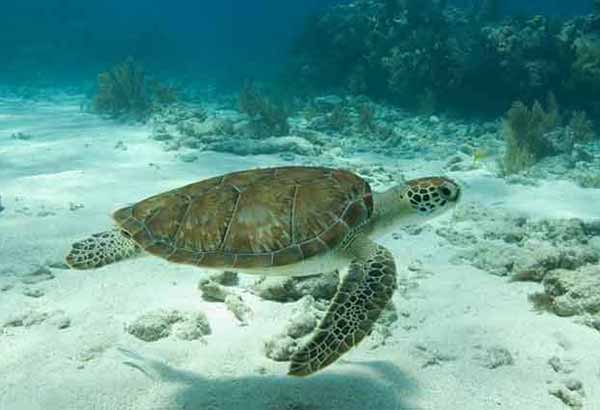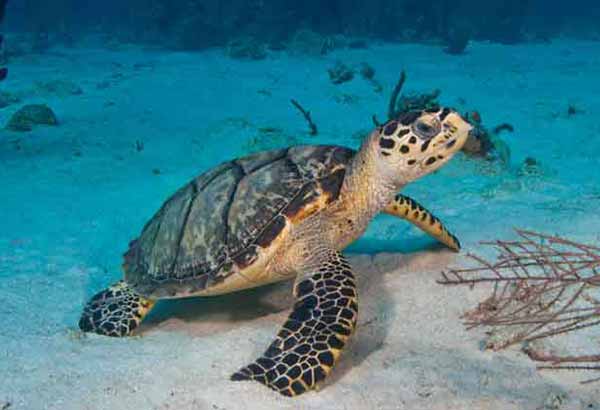Swimming
Sea turtles are strong swimmers.
- The cruising speed for green sea turtles is about 1.5 to 2.3 kph (0.9 to 1.4 mph).
- Leatherbacks have been recorded at speeds of 1.5 to 9.3 kph (0.9 to 5.8 mph).
Forelimbs are modified into long, paddlelike flippers for swimming while the neck and limbs are non-retractile. The shell adaptations necessary for retractile extremities would impede rapid swimming.
With the exception of females that come ashore to nest, sea turtles spend their entire lives at sea and are well adapted to an aquatic existence.

Diving
Sea turtles are excellent divers. They typically spend most of their time beneath the ocean’s surface, up to 94% to 97%, which may help reduce predation and energy use.
Leatherbacks routinely dive more than 305 m (1,000 ft.). They may reach depths of more than 1,190 m (3,900 ft.) seeking jellyfish for prey.
Since they are cold-blooded, sea turtles have a slow metabolic rate. This slowed metabolism allows them to stay submerged for long periods of time.
- Hawksbill turtles have been known to remain submerged for 35 to 45 minutes.
- Green sea turtles can stay under water for as long as 5 hours. Their heart rate slows to conserve oxygen: 9 minutes may elapse between heartbeats.
- Green and black sea turtles in some subtropical lagoons will burrow in the mud and hibernate throughout the chilly winter to slow their metabolism. The hibernating turtles breathe without surfacing by absorbing dissolved oxygen through their skin and cloaca.
During long dives, blood is shunted away from tissues tolerant of low oxygen levels toward the heart, brain, and central nervous system.
Leatherbacks have high concentrations of red blood cells; therefore, they can retain more oxygen. The muscle of leatherbacks has a high content of the oxygen-binding protein myoglobin. Myoglobin transports and stores oxygen in muscles tissue.
Respiration
Lung capacity exchange per breath ranges from 27% to 80% for sea turtles, which is much higher than for land reptiles. This enables sea turtles to completely exchange all of the gases within their lungs in just a few breaths.

Salt Secretion
Sea turtles can live in seawater with no need for a freshwater source. They obtain sufficient water from their diet and from metabolizing seawater.
Like other marine reptiles and seabirds, sea turtles have a salt gland to rid their bodies of excess salt. This gland empties into the sea turtles' eyes. The secretion of salt and fluid makes them look as if they are "crying" when they come ashore. These "tears" also help keep the eyes free of sand while females dig their nests.
Sea Turtles on Land
For the most part, the only time sea turtles leave the sea is when females haul out on shore to lay eggs. Many adaptations that make sea turtles successful in the sea make them slow and vulnerable on land.
On some uninhabited or sparsely-inhabited beaches, turtles have been observed basking on land.
- Green turtles regularly bask in the sun on some beaches in the Galápagos Islands, Hawaiian Islands, and Australia. Basking in the sun warms turtles up above the water temperature, and lets them increase their activity levels. Once their carapace temperature reaches about 40°C (104°F), the turtles use their flippers to toss sand on their backs to cool down.



